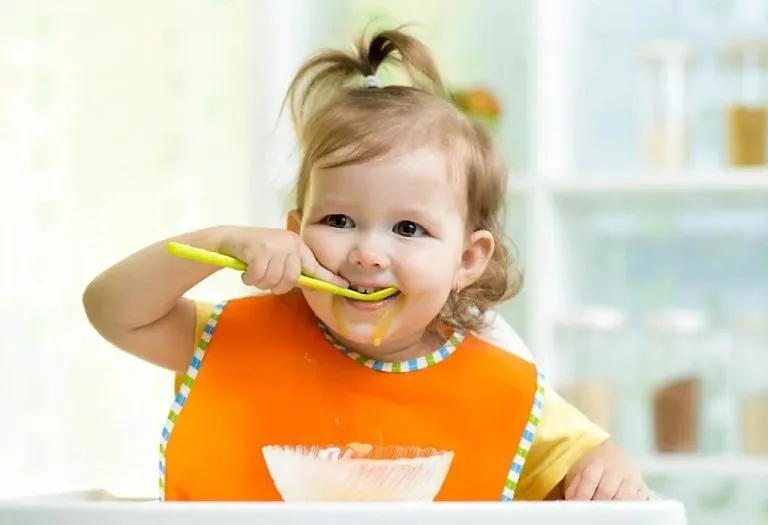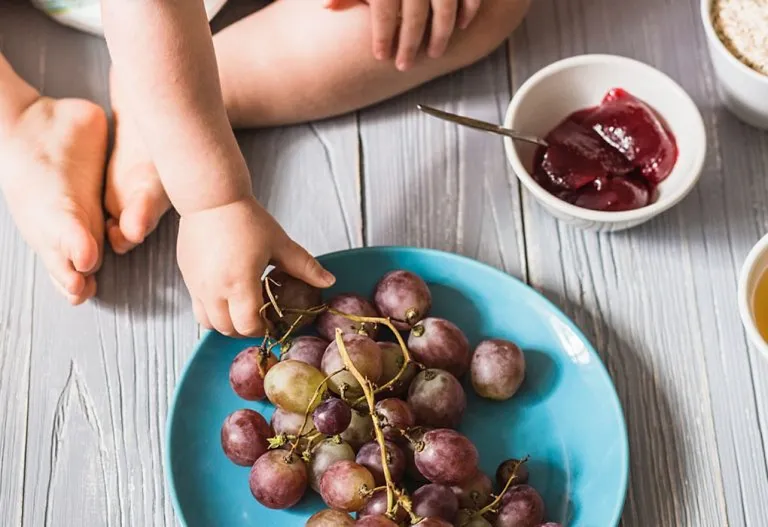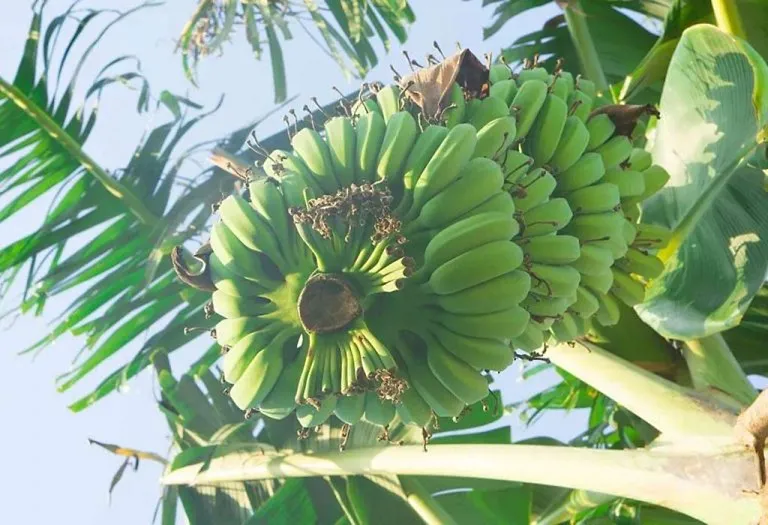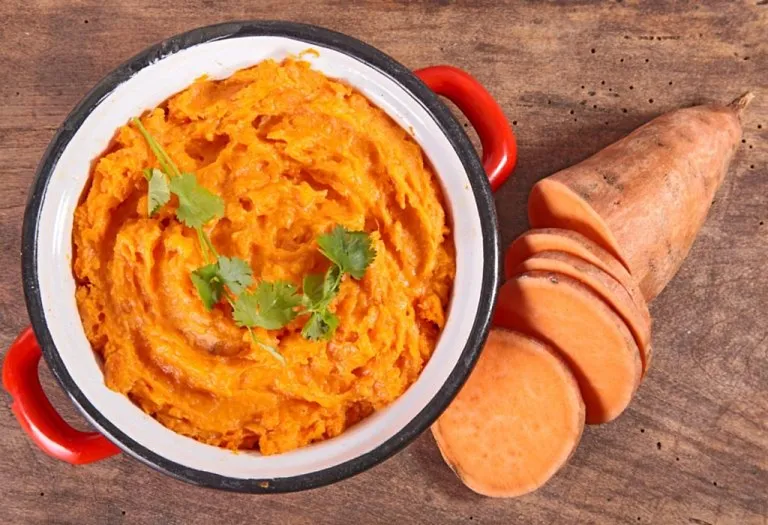Wheat for Babies – Benefits, When & How to Introduce?

- Is Wheat Good for Babies?
- When Should You Introduce Wheat to a Baby’s Diet?
- Nutritional Value of Wheat
- Health Benefits of Wheat for Infants
- Side-Effects of Wheat on Babies
- How to Introduce Wheat to Your Baby?
- Things to Consider Before Feeding Wheat to a Baby
- Wheat Recipes for Your Child?
- FAQs
When your baby reaches the age when he can be given solids, the entire spectrum of foods opens up, making you wonder what item you should start with first. It is often recommended to start with cereals and check how well your baby accepts them. Rice cereal is usually popular among many, but you can even introduce wheat to your baby. Wheat brings many nutritional benefits crucial for your baby’s growth and development. When introducing wheat to a baby’s diet, it’s essential to approach it with care and consideration. Keep reading to discover the benefits of wheat for babies and learn the best practices for introducing it into their diet.
Is Wheat Good for Babies?
Wheat can benefit babies when introduced at the appropriate stage of their development. Wheat is a rich source of energy, fibre, and essential nutrients such as iron and B vitamins necessary for a baby’s growth and development (2). Including wheat in a baby’s diet can contribute to their overall nutrition and help support their increasing energy needs as they grow. However, it’s important to introduce wheat gradually and watch for any signs of allergies or digestive discomfort.
When Should You Introduce Wheat to a Baby’s Diet?
Before you start making wheat halwa and give it to your child, it is important to note whether your baby is ready. Many people believe that a baby is ready to eat solid foods after he has completed about six months of age. A consensus among doctors and other parents usually stays at completing at least a year before solids begin to find their way to a baby’s mouth (3). Keep track of how your baby responds, and let your doctor know before introducing any other item to your baby’s diet.
Nutritional Value of Wheat
Wheat is a staple crop globally, valued for its versatility in culinary applications and rich nutritional profile. As a significant source of carbohydrates, wheat provides essential energy for the body. Here’s a breakdown of the nutritional content found in 100 g of wheat (1):
| Nutrients | Value |
| Water | 12.4 g |
| Energy | 332 kcal |
| Protein | 9.61 g |
| Carbohydrate, by difference | 74.5 g |
| Fibre, total dietary | 13.1 g |
| Calcium, Ca | 33 mg |
| Iron, Fe | 3.71 mg |
| Magnesium, Mg | 117 mg |
| Phosphorus, P | 323 mg |
| Potassium, K | 394 mg |
| Sodium, Na | 3 mg |
| Zinc, Zn | 2.96 mg |
| Copper, Cu | 0.475 mg |
| Manganese, Mn | 3.4 mg |
| Selenium, Se | 12.7 µg |
| Folate, total | 28 µg |
Health Benefits of Wheat for Infants
Wheat is recommended for babies purely because it offers a trove of benefits essential in a child’s early growth phase. Here are several health benefits of introducing wheat to the diet of infants:
1. Supports Oral Development
Wheat-based food items must be chewed properly before swallowing. Babies under one year old cannot chew, as their teething is still in progress. Chewing teeth develop slightly later than biting teeth. The act of chewing helps exercise the jaw and gums, developing and strengthening the oral organs. This helps boost blood circulation in the gums, promoting dental health and reducing the chances of dental cavities occurring early in life.
2. Great Nutrition Source
Wheat has numerous nutritive constituents, including vitamin B, dietary fibre, manganese, phosphorous, niacin, and many other minerals (4). All of these play an important role in the physical and mental growth of babies in the early years.
3. Streamlines Digestive Process
Constipation and many other digestion-related ailments frequently plague young kids since their digestive systems are not developed. Food needs to be digested properly in order to absorb the various nutrients contained in it. Wheat is quite easy to digest, and its constituents are also beneficial for intestinal health (5).
4. A Powerhouse of Carbohydrates
In most cuisines, wheat forms a substantial and core part of the meal purely because of one reason: carbohydrates. Carbohydrates are an important source of energy. A baby needs energy for his various bodily processes and growth. Serving wheat helps him get the energy he needs and stimulates proper physical development.
Side-Effects of Wheat on Babies
Introducing wheat into a baby’s diet can offer numerous nutritional benefits, but it’s also essential to be aware of potential side effects. While wheat allergies are uncommon, some babies may experience adverse reactions or sensitivities to wheat proteins. Here are some possible side effects of wheat on babies to be mindful of:
1. Digestive Discomfort
Some babies may experience gas, bloating, or diarrhoea after consuming wheat-based foods, indicating possible digestive sensitivity or intolerance.
2. Allergic Reactions
Although rare, wheat allergies can cause symptoms such as hives, eczema, or even anaphylaxis in severe cases (6). It’s of utmost importance to monitor for any signs of allergic reactions when introducing wheat to a baby’s diet.
3. Celiac Disease
Babies with celiac disease have an autoimmune reaction to gluten, a protein found in wheat (7). Consuming wheat can trigger symptoms such as abdominal pain, diarrhoea, and failure to thrive in affected infants.
How to Introduce Wheat to Your Baby?
Making wheat biscuits for babies might be a great way to start your little one on wheat. However, specific points should be kept in mind when introducing wheat to your child correctly.
- Let your child eat different solid food items before you introduce wheat to him.
- Opt for fruit-based purees, then transition to a wheat porridge to give him balanced nutrition.
- Introduce new food items after a gap of a week or so. This helps you gauge any allergic reactions that might arise.
- Do not reduce breastfeeds to make way for solid food items; let it continue as before. You can alternate between breastfeeds and solids.
- Stop serving the food if you notice an allergic reaction after giving your child a new food item.
- Mix it with other food items if your child initially dislikes the taste.

Things to Consider Before Feeding Wheat to a Baby
Before starting with any recipe for your child, make sure that you adhere to certain precautions and considerations for the benefit of your kid.
- At times, wheat consumption can trigger specific allergies or reactions such as breathing problems or even asthma. Avoid giving your child wheat-based items in high quantities in such cases, or stop them altogether. Your doctor might have specific alternatives to help him cope with it.
- There is a difference between giving your child the usual wheat and wheat flour. The baby can accidentally inhale wheat flour, which finds its way right into the blood. This triggers the baby’s immune system to react to a foreign body, resulting in a wheat-based allergy.
- Whole wheat may be difficult for babies to digest initially. It is best to start with simple recipes based on processed wheat so your child gets used to it safely and gradually.
Wheat Recipes for Your Child?
Introducing wheat-based recipes into your child’s diet can provide a versatile and nutritious addition to their meals. Here’s a list of delicious recipes to inspire healthy eating habits from an early age.
1. Wheat Porridge
Starting with a wheat-based porridge is easy and safe to check if he likes it and responds positively. Later, the porridge can be mixed with other elements to elevate the flavour or mixed with cow milk as well.
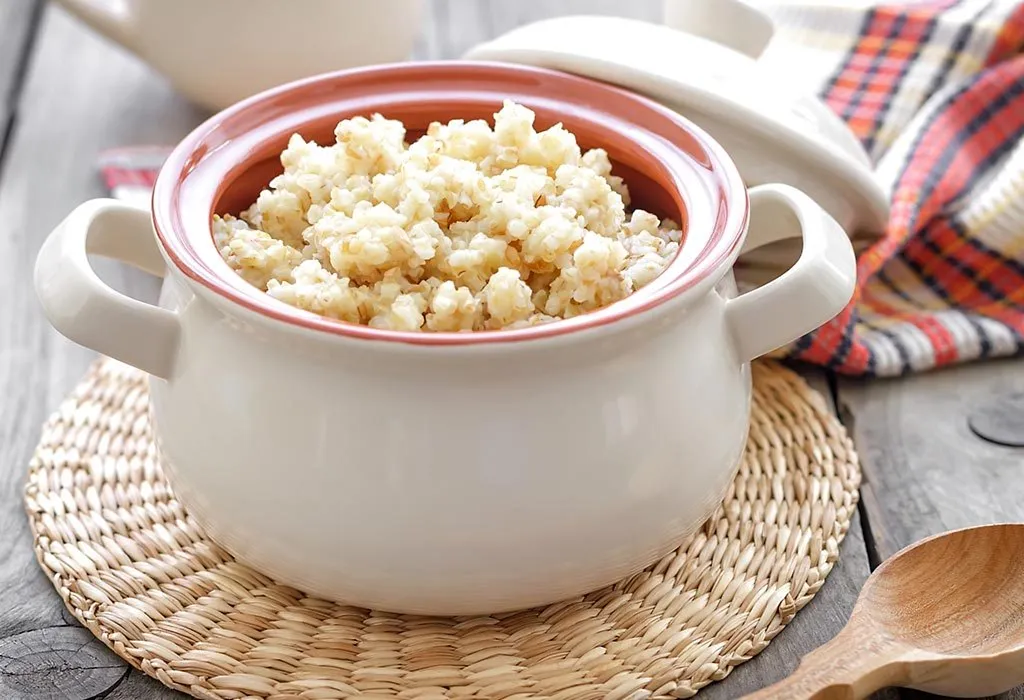
What You Will Need
- Wheat flour
- Moong dal
- Almonds
- Jaggery, powdered (only for babies older than 1 year)
- Cow milk (only for babies older than 1 year)
- Water
How to Prepare
- Start with preparing the wheat mix powder. Heat a pan and roast almonds on low flame for a few minutes until their colour changes.
- Roast the moong dal next until it changes colour. Once it cools, add it to a blender with the almonds and blend to a smooth powder. Sieve it to get a fine version.
- Now, roast the flour in the pan until you can smell the aroma. Remove the heat and add the powder, mixing them together. This is your wheat mix.
- Place jaggery and water in a vessel and boil until it melts. Filter this water and mix it with the wheat flour mixture. Add some more water and mix everything properly without any lumps.
- Cook this on a medium flame, stirring continuously, and add milk. Boil it until the porridge thickens.
- Take it off the flame and let it cool down so that it may thicken further, then serve.
- Ensure your baby is not allergic to almonds or nuts before making and serving this recipe.
2. Wheat Pancakes
Wheat pancakes are a delightful and nutritious option for your child’s breakfast or snack time. Packed with the goodness of whole wheat flour, these pancakes can be customised with various toppings to suit your child’s taste preferences. Here’s how you can make them:
What You Will Need
- Whole wheat flour
- Baking powder
- Milk (or plant-based milk for dairy-free option)
- Egg (optional)
- Honey or maple syrup (optional)
- Fresh fruits like bananas or berries for topping
How to Prepare
- Mix 1 cup of whole wheat flour and 1 teaspoon of baking powder in a mixing bowl.
- If using, beat 1 egg in a separate bowl and add it to the flour mixture.
- Gradually pour 1 cup of milk while stirring until you achieve a smooth batter consistency.
- Heat a non-stick pan over medium heat and lightly grease it with oil or butter.
- Pour a ladleful of batter onto the pan to form pancakes of the desired size.
- Cook until bubbles appear on the surface, flip the pancakes and cook until golden brown on both sides.
- Serve the pancakes warm, drizzled with honey or maple syrup, and topped with fresh fruits.
3. Wheat Banana Muffins
Wheat banana muffins are a wholesome and delicious treat your child will love. These muffins are perfect for breakfast on the go or as a healthy snack option.
What You Will Need
- Whole wheat flour
- Ripe bananas
- Honey or maple syrup
- Baking powder
- Cinnamon powder (optional)
- Vanilla extract
- Eggs (or flaxseed meal as an egg substitute)
- Milk (or almond milk for a dairy-free option)
- Muffin liners
How to Prepare
- Preheat your oven to 350°F (175°C) and line a muffin tin with liners.
- Mash 2 ripe bananas with a fork until smooth in a mixing bowl.
- Add 1/3 cup honey or maple syrup, two eggs (or flaxseed meal mixture), one teaspoon vanilla extract, and 1/3 cup milk to the mashed bananas, and mix well.
- Combine 1 1/2 cups whole wheat flour, one teaspoon baking powder, and 1/2 teaspoon cinnamon powder in another bowl.
- Gradually add the dry ingredients to the wet ingredients, stirring until combined.
- Pour the batter into the prepared muffin liners, filling each about two-thirds full.
- Bake in the oven for 20-25 minutes or until a toothpick inserted into the centre comes clean.
- Allow the muffins to cool before serving. These nutritious wheat banana muffins make a tasty snack or breakfast option for your child!
4. Broken Wheat Porridge (Daliya)
Made from broken wheat grains, this porridge is packed with fibre, vitamins, and minerals, making it an excellent choice for supporting your child’s growth and development.
What You Will Need
- Broken wheat (Daliya)
- Water
- Milk (optional)
- Sugar or jaggery (optional)
- Ghee (clarified butter)
- Cardamom powder (optional)
- Chopped nuts (such as almonds or cashews) for garnish
How to Prepare
- Rinse 1/2 cup of broken wheat thoroughly under running water to remove impurities.
- Bring 2 cups of water to a boil in a saucepan and add the rinsed broken wheat.
- Reduce the heat to low and let the broken wheat simmer, stirring occasionally, until it is cooked and has absorbed most of the water. This usually takes about 15-20 minutes.
- If desired, add 1/2 cup of milk to the porridge to make it creamier and richer in taste. Pour in the milk and cook until the porridge reaches your desired consistency.
- Sweeten the porridge with sugar or jaggery according to your child’s preferences. Alternatively, you can omit the sweetener if you prefer a savoury version.
- Add a pinch of cardamom powder for the desired flavour, and mix well.
- Heat ghee in a separate small pan and lightly roast the chopped nuts until they are golden brown and fragrant.
- Pour the ghee and roasted nuts over the prepared Daliya and mix gently.
- Serve the broken wheat porridge warm in bowls, garnished with additional nuts if desired.
FAQs
1. What are the signs of wheat allergy or intolerance in babies?
Signs of wheat allergy or intolerance in babies may include rashes, hives, vomiting, diarrhoea, or difficulty breathing (8). If you notice these symptoms after introducing wheat, consult your paediatrician immediately.
2. Can I give wheat to my baby if there’s a family history of wheat allergies?
If there’s a family history of wheat allergies, you must be cautious when introducing wheat to your baby. Consult your paediatrician before introducing wheat, and closely monitor your baby for any signs of allergic reactions.
3. Are there any alternatives to wheat for babies with allergies or sensitivities?
If your baby has allergies or sensitivities to wheat, you can explore alternative grains such as rice, oats, barley, or quinoa. These grains offer similar nutritional benefits and can be used to create a variety of nutritious and delicious foods for your baby.
4. How can I ensure my baby’s diet includes enough wheat for optimal nutrition?
To ensure your baby’s diet includes enough wheat for optimal nutrition, offer a variety of wheat-based foods along with other grains, fruits, vegetables, proteins, and dairy products. Monitor your baby’s intake and consult your paediatrician or a registered dietitian for personalised guidance.
Introducing wheat to your child can also open the gates of solid food items to newer elements. Taking care of your little one’s age and preparing a wheat-based meal correctly is extremely important to avoid any problems later. Let your child enjoy the taste of various wheat food items and grow into a healthy toddler!
References/Resources:
1. Wheat flour, whole-grain, soft wheat; U.S. DEPARTMENT OF AGRICULTURE; https://fdc.nal.usda.gov/fdc-app.html#/food-details/168944/nutrients
2. Shewry. P. R, Hey. S. J; The contribution of wheat to human diet and health; PubMed Central; https://www.ncbi.nlm.nih.gov/pmc/articles/PMC4998136/; August 2015
3. Porto. A; When should I introduce wheat into my baby’s diet?; American Academy of Pediatrics; https://www.healthychildren.org/English/tips-tools/ask-the-pediatrician/Pages/When-should-I-introduce-wheat-into-my-babys-diet.aspx
4. Shewry. P. R; Wheat; PubMed; https://pubmed.ncbi.nlm.nih.gov/19386614/
5. Cooper. D. N, Martin. R. J, Keim. N. L; Does Whole Grain Consumption Alter Gut Microbiota and Satiety?; PubMed Central; https://www.ncbi.nlm.nih.gov/pmc/articles/PMC4939539/; May 2015
6. Wheat; American College of Allergy, Asthma & Immunology; https://acaai.org/allergies/allergic-conditions/food/wheat-gluten/
7. Celiac Disease in Children; Celiac Disease Foundation; https://celiac.org/about-celiac-disease/celiac-disease-in-children/
8. Wheat Allergy; Children’s Hospital of Philadelphia; https://www.chop.edu/conditions-diseases/wheat-allergy
Beans for Babies
Brown Rice for Babies
Lentils (Dal) for Infants
Millet (Bajra) for Babies
Was This Article Helpful?
Parenting is a huge responsibility, for you as a caregiver, but also for us as a parenting content platform. We understand that and take our responsibility of creating credible content seriously. FirstCry Parenting articles are written and published only after extensive research using factually sound references to deliver quality content that is accurate, validated by experts, and completely reliable. To understand how we go about creating content that is credible, read our editorial policy here.









